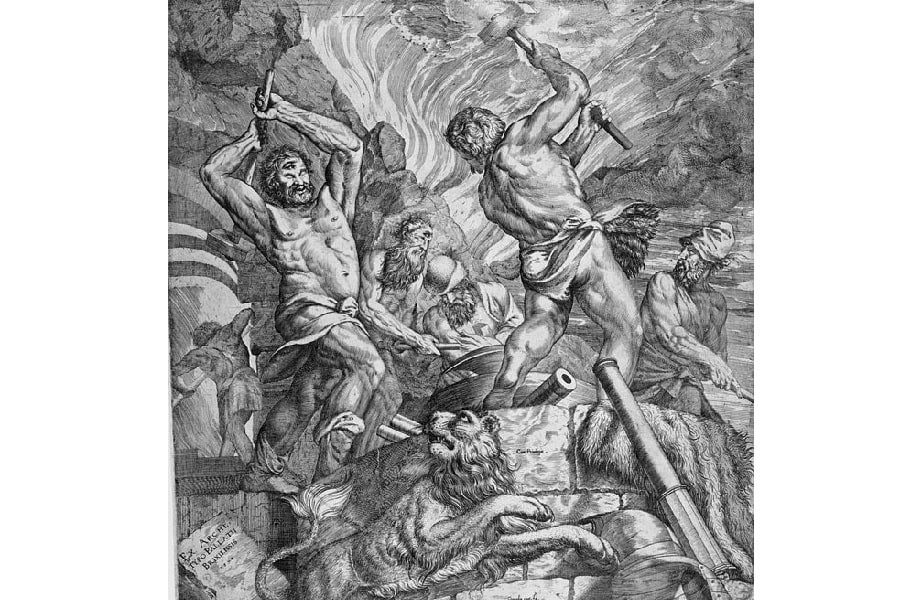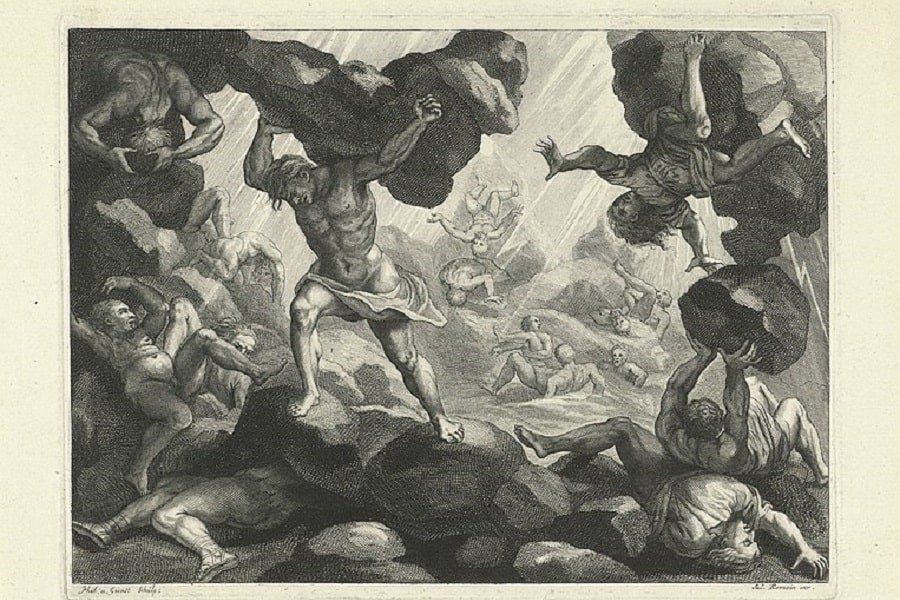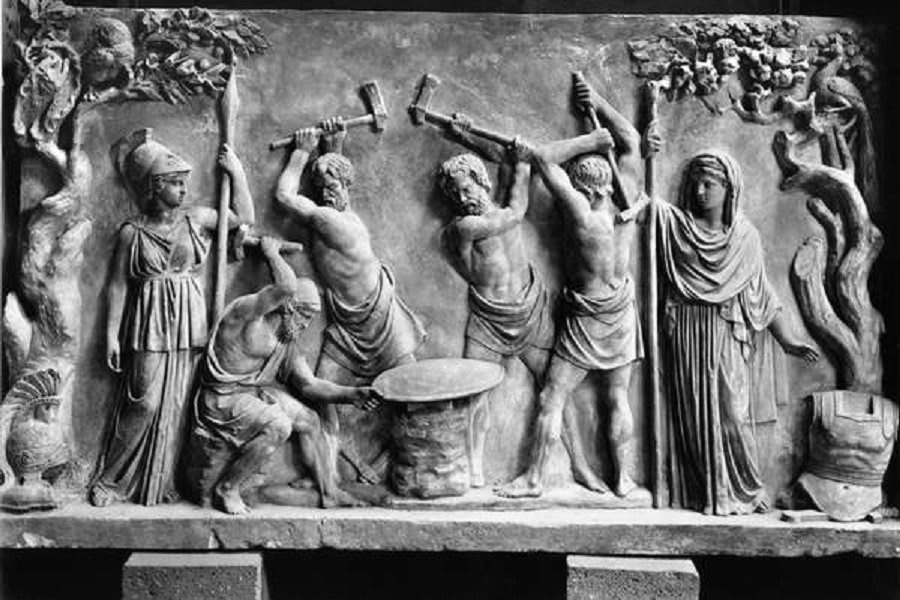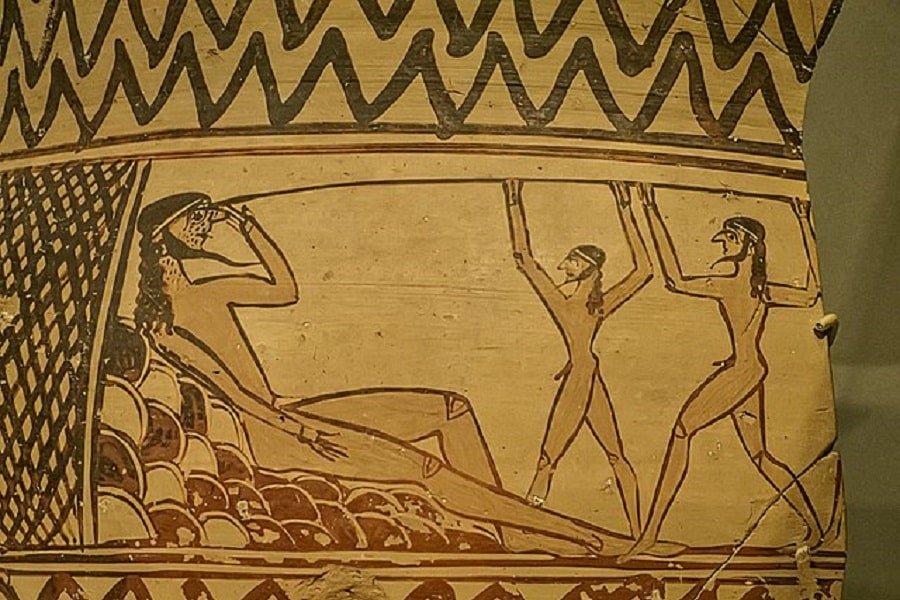Cyclopes are supernatural beings of immense stature and strength and have just one eye. Cyclopes played a rather minor role in Greek mythology, even though many wrote of them. They did not fall in the category of Greek gods and goddesses but were one of the many other creatures that populated the ancient myths.
Table of Contents
What Are Cyclopes?

A cyclops, called cyclopes in the plural, was the one-eyed giant of Greek mythology. They were widely considered monsters on par with the empusa or the lamia because of their fearsome and destructive abilities.
The mythology behind the cyclopes is complicated. There is no one definition or nature that can be ascribed to the creatures because there are three different sets of beings who have been given the name. According to whichever writer was telling the stories, the cyclopes can be seen as monsters and villains or ancient entities who were wronged by their all-powerful father and turned to violence.
What Does the Name Mean?
The word ‘cyclops’ may have been derived from the Greek word ‘kuklos’ meaning ‘circle’ or ‘wheel’ and ‘opos’ meaning eye. Thus, ‘cyclops’ literally translates into ‘circle eyed’ or ‘round eyed.’ This was because the cyclopes were depicted with a single circle-shaped eye in the middle of their forehead.
However, the Greek word ‘klops’ means ‘thief’ so scholars have theorized that ‘cyclops’ could have originally meant ‘cattle thief’ or ‘sheep thief.’ Since this would also describe the creatures quite well, it could have been the original meaning of the name. It is possible that the depictions of the cyclopes were influenced by the meaning and in later years they grew to look like the monsters we are familiar with.
Origins of Cyclopes
A lot of world mythology and the creatures found therein is simply the product of the imaginations of ancient civilizations. However, as far as cyclopes are concerned, a paleontologist named Othenio Abel suggested a theory in 1914. Having found fossils of dwarf elephants in coastal caves of Italy and Greece, Abel proposed that the discovery of these fossils was the origin of the cyclops myth. A large nasal cavity in the center of the skull could have led the ancient Greeks to theorize that the creatures had only one eye in the center of their forehead.
However, folktales about a creature like the cyclops have been found throughout the ancient world. The Grimm brothers collected tales of such beings from all over Europe. Modern scholars have concluded that such tales existed from Asia to Africa and predated the Homeric epics. Thus, it seems unlikely that a particular kind of fossil was responsible for the origins of the myth. Like dragons, these one-eyed giants seem ubiquitous.
Types of Cyclopes
There are three main kinds of cyclopes in the ancient myths of Greece. The most well-known of these are Hesiod’s cyclopes, a group of three cyclopes who were the brothers of the Titans. There were also Homer’s cyclopes, the large one-eyed monsters who dwelt on lofty mountains, in hollow caves, and faced off against Homer’s hero, Odysseus.
Other than these, there is one more obscure reference to cyclopes. These last ones are the wall builders who built the so-called Cyclopean walls of Mycenae, Argos, and Tiryns. These mythic master builders were often mentioned in texts from antiquity. They shared some similarities with the Hesiodic cyclopes but were not thought to be the same beings.

Traits and Skills
The Hesiodic cyclopes were more than just one-eyed giants and monsters. There is not much resemblance between the cyclopes and the Greek gods in other regards, they were supposed to be extremely skilled craftsmen. Their great strength aided them in this. It was the cyclopes who created the mighty thunderbolt of Zeus.
The Greeks and the Romans both had cyclopes working at forges and smithies. They created armor, weapons, and chariots for the gods. Astral myths from the Hellenistic era even claimed that the cyclopes built the very first altar. This altar was later placed in the heavens as a constellation.
The Homeric cyclopes were supposed to be shepherds and sheep farmers.
Master Craftsmen and Builders
A cyclops had much greater strength than the average human. This fact was used to explain the fact that the Cyclopean walls of Mycenae were made up of stones that were too large and heavy for a human being to lift.
The builder cyclopes are mentioned by poets like Pindar and natural philosophers by Pliny the Elder. They are not individually named but they were said to be builders and craftsmen of extraordinary skill. The mythic king Proetus of Argos supposedly brought seven of these beings to his kingdom to build the walls of Tiryns. Stretches of these walls can be found in the Acropoli of Tiryns and Mycenae today.
Pliny, quoting Aristotle, stated that the cyclopes were believed to have invented masonry towers. Apart from that, they were the first to work with iron and bronze. It is quite possible that the cyclopes mentioned by the ancient greats were simply a group of humans who were skilled builders and artisans, not the monstrous giants of Hesiodic and Homeric myth.

Mythology
The cyclops found in Homer’s Odyssey is an evil entity, selfish and violent for no good reason. But this is not really true of the cyclopes in Hesiod’s works. While he did say that they had ‘very violent hearts,’ there is a reason behind it. Having been unfairly reviled and punished for their appearances by their father and brother, is it any wonder that they were angry? The fact that they were such skilled craftsmen and builders seems to imply that they were not just brutal and mindless monsters.
Sons of Uranus and Gaia
Hesiod’s cyclopes were the children of the primordial mother goddess Gaia and the sky god Uranus. We learn about them in the poem Theogony. Uranus and Gaia had eighteen children – the twelve Titans, three Hecatoncheires, and three Cyclopes. The names of the three cyclopes were Brontes (Thunder), Steropes (Lightning), and Arges (Bright). The Cyclopes had a single eye in their foreheads while the Hecantoncheires had a hundred hands each. All the children of Gaia and Uranus, however, were gigantic in stature.
While their father Uranus was fond of the beautiful Titans, he hated his monstrous-looking children. Thus, he imprisoned the Cyclopes and the Hecatoncheires deep inside the earth, in their mother’s chest. The cries of her children from within her breast and her helplessness made Gaia furious. She decided that Uranus needed to be defeated and went to the Titans for help.
It was her youngest son, Cronus, who finally overthrew his father and slew him, helped by several of his brothers. However, Cronus then refused to free the Cyclopes and Hecatoncheires, who at this point were imprisoned in Tartarus, the underworld during the reign of the Titans.
The Cyclopes in the Titanomachy
When Cronus refused to free his brothers, Gaia grew angry at him and cursed him. She said that he too would be defeated and overthrown by his son as he had overthrown his father. Afraid of this very fact, Cronus swallowed all his newborn children whole so that they could not grow up to defeat him.
Cronus was foiled by his sister-wife Rhea, who managed to save their sixth and youngest child. She offered him a stone wrapped in swaddling cloth to swallow. The child meanwhile grew up to become Zeus. Zeus grew up, forced Uranus to vomit up his children, and declared war against the Titans. This war was known as the Titanomachy. Zeus also freed the Cyclopes and Hecatoncheires so they would help him in the war.
The Cyclopes helped forge Zeus’ thunderbolt during the Titanomachy. Even the names given to them by Hesiod reflect this particular weapon. With the thunderbolt, Zeus defeated the Titans and became the ultimate ruler of the cosmos.

In the Odyssey
The Odyssey is one of Homer’s world-renowned epics, about the travels of Odysseus after the Trojan War. One story tells of the famous encounter between the mythic hero and a certain cyclops, Polyphemus.
Odysseus found himself in the land of the cyclopes during his travels. His adventures there is a story that he tells in hindsight, while he is being hosted by the Phaeacians. He describes the cyclopes as lawless people who have no art and no culture and do not sow or plow. They only throw seeds on the ground and these spring up automatically. The cyclopes do not respect Zeus or any of the gods because they consider themselves far superior. They dwell in caves on top of mountains and continuously plunder their neighboring lands.
Polyphemus is said to be the son of the sea god Poseidon, and a nymph called Thoosa. When Odysseus and his men enter the cave of Polyphemus for supplies, they get trapped inside with the cyclops. He blocks the entrance with a massive stone and eats two of the men. While most of his men are eaten, Odysseus manages to trick the cyclops and blind it. He and his remaining men escape by clinging to the underside of Polyphemus’ sheep.
While Homer does not provide an exact description of Polyphemus, by the circumstances of the story we can say that he did indeed have one eye. If all the others were like him, then the Homeric cyclopes were the one-eyed giant sons of Poseidon. Homer’s descriptions of the cyclopes are very different from the Hesiodic account.
Polyphemus and Galatea
Before Polyphemus met Odysseus, the cyclops fell in love with a beautiful nymph, Galatea. However, because of his crude and barbaric nature, Galatea did not return his feelings. When she spurned him for the love of a young man named Acis, the son of Faunus and a river nymph, Polyphemus grew angry. He brutally killed the young man by throwing a gigantic rock at him. It is said that his blood gushed out of the rock and created a stream that still bears his name.
Different accounts exist of this tale. A certain lesser-known “Beauty and the Beast” type version ends with Galatea accepting Polyphemus’ advances after he sings a love song for her, and they have a son together. The son is named Galas or Galates and was believed to be the ancestor of the Gauls.
Thus, it is evident that the Homeric cyclopes were little more than murderous, violent beasts. They had no skills or talents and were not obedient to the will of Zeus. It is interesting that within the same civilization, two such divergent views of a single entity existed.

Cyclops in Ancient Literature and Art
Many ancient poets and playwrights have included the cyclopes in their tales. They were also often depicted in the art and sculpture of ancient Greece.
Euripedes
Euripides, the tragic playwright, wrote about the different kinds of cyclopes in different plays. Alcestis talks about the Hesiodic cyclopes who forged Zeus’ weapon and were killed by Apollo.
Cyclops, the satyr play, on the other hand, deals with Homer’s cyclopes and the encounter between Polyphemus and Odysseus. Euripedes states that the cyclopes live on the island of Sicily and describes them as the one-eyed sons of Poseidon who dwell in mountain caves. They are a people who have no cities, no agriculture, no dancing, and no recognition of important traditions like hospitality.
The Cyclopean wall builders also find a mention in Euripedean plays. He praises the walls and temples of Mycenae and Argos and specifically makes mention of various structures that the cyclopes built. Since this does not fit with the Homeric idea at all, we must conclude that these were different groups of people sharing the same name.
Callimachus
The third-century BC poet, Callimachus, writes of Brontes, Steropes, and Arges. He makes them the assistants to Hephaestus, the smith of the gods. As per Callimachus, they made the quiver, arrows, and bow of the goddess Artemis and Apollo. He states that they live on Lipari, one of the Aeolian islands just off Sicily.

Virgil
Virgil, the great Roman poet, again writes of both the Hesiodic cyclopes as well as Homer’s cyclopes. In the Aeneid, where the hero Aeneas follows in the footsteps of Odysseus, Virgil locates the two groups of cyclopes near each other, around the island of Sicily. The latter are described in book three as being like Polyphemus in size and shape and there were a hundred of them.
In book eight, Virgil states that Brontes and Steropes, and a third cyclops whom he calls Pyracmon work in a large network of caves. These caves stretch from Mount Etna to the Aeolian islands. They assist Vulcan, the Roman god of fire, in making armor and weapons for the gods.
Apollodorus
Apollodorus, who wrote an ancient compendium of the myths and legends of Greece called the Bibliotheca, made the cyclopes quite similar to Hesiod’s. Unlike Hesiod, he has the Cyclopes being born after the Hecatoncheires and before the Titans (the order is exactly the reverse in Hesiod).
Uranus threw the Cyclopes and Hecatoncheires into Tartarus. When the Titans rebelled and slew their father, they released their brothers. But after Cronus was crowned king, he again imprisoned them in Tartarus. When the Titanomachy broke out, Zeus learned from Gaia that he would win if he released the Cyclopes and Hecatoncheires. Thus, he slew their jailer Campe and freed them. The Cyclopes made Zeus’s thunderbolt as well as Poseidon’s trident and Hades his helmet.
Nonnus
Nonnus wrote the Dionysiaca, the longest surviving poem from antiquity. The subject of the poem is the life of the god Dionysus. It describes a war waged between Dionysus and an Indian king called Deriades. Ultimately, the troops of Dionysus are joined by the cyclopes who are great warriors and manage to crush the forces of Deriades.
Greek Pottery
The early black-figure pottery from ancient Greece often depicted the scene where Odysseus blinds Polyphemus. It was a popular motif and the earliest example found of it was on an amphora from the seventh century BCE. Found in Eleusis, this particular scene depicts Odysseus and two men carrying a long spiked pole above their heads. The interesting aspect of this particular piece of pottery is that one of the men is depicted in white, although it was a color traditionally reserved for women. This vase and several others of its kind can be found in the archaeological museum at Eleusis. The popularity of this scene died down by the era of the red figure pottery.

Paintings and Sculpture
The cyclopes are also a popular motif in Roman sculptures and mosaics. They were often shown as giants with one large eye on the center of their foreheads and two closed normal eyes. Galatea and Polyphemus’ love story was also quite a popular subject.
The amphitheater of Salona in Croatia has a very impressive stone head of a cyclops. The villa of Tiberius in Sperlonga features a well-known sculptural representation of Odysseus and his men blinding Polyphemus. The Romans also used the face of a cyclops as a stone mask for pools and fountains. These can be found all around Europe and also usually have three eyes.
Cyclops in Pop Culture
In modern parlance, Cyclops is the nom de guerre of Scott Summers, one of the characters from the X-Men comic books in the Marvel universe. He is one of the mutants in the books, beings of unusual powers who cannot assimilate with ordinary human beings. His power manifested as he was a young boy, in the form of an uncontrollable blast of destructive force from his eyes. Scott Summers was the first of the X-Men assembled by Charles Xavier, another mutant.
It is not surprising why Cyclops was the name given to this character since the distinctive feature of both were the eyes. However, there is no evidence that the cyclopes of myth had any destructive power or optic force that they could shoot out of their eyes.